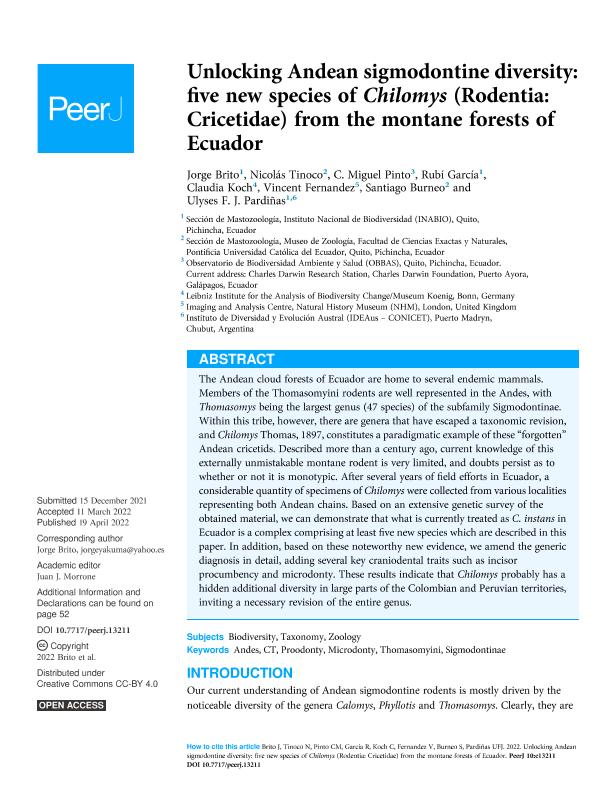Mostrar el registro sencillo del ítem
dc.contributor.author
Brito, Jorge
dc.contributor.author
Tinoco, Nicolás
dc.contributor.author
Pinto, C. Miguel
dc.contributor.author
García, Rubí
dc.contributor.author
Koch, Claudia
dc.contributor.author
Fernandez, Vincent
dc.contributor.author
Burneo, Santiago
dc.contributor.author
Pardiñas, Ulises Francisco J.

dc.date.available
2023-10-30T14:07:08Z
dc.date.issued
2022-04
dc.identifier.citation
Brito, Jorge; Tinoco, Nicolás; Pinto, C. Miguel; García, Rubí; Koch, Claudia; et al.; Unlocking Andean sigmodontine diversity: five new species of Chilomys (Rodentia: Cricetidae) from the montane forests of Ecuador; PeerJ Inc.; PeerJ; 10; 4-2022; 1-60
dc.identifier.issn
2167-8359
dc.identifier.uri
http://hdl.handle.net/11336/216375
dc.description.abstract
The Andean cloud forests of Ecuador are home to several endemic mammals. Members of the Thomasomyini rodents are well represented in the Andes, with Thomasomys being the largest genus (47 species) of the subfamily Sigmodontinae. Within this tribe, however, there are genera that have escaped a taxonomic revision, and Chilomys Thomas, 1897, constitutes a paradigmatic example of these “forgotten” Andean cricetids. Described more than a century ago, current knowledge of this externally unmistakable montane rodent is very limited, and doubts persist as to whether or not it is monotypic. After several years of field efforts in Ecuador, a considerable quantity of specimens of Chilomys were collected from various localities representing both Andean chains. Based on an extensive genetic survey of the obtained material, we can demonstrate that what is currently treated as C. instans in Ecuador is a complex comprising at least five new species which are described in this paper. In addition, based on these noteworthy new evidence, we amend the generic diagnosis in detail, adding several key craniodental traits such as incisor procumbency and microdonty. These results indicate that Chilomys probably has a hidden additional diversity in large parts of the Colombian and Peruvian territories, inviting a necessary revision of the entire genus.
dc.format
application/pdf
dc.language.iso
eng
dc.publisher
PeerJ Inc.
dc.rights
info:eu-repo/semantics/openAccess
dc.rights.uri
https://creativecommons.org/licenses/by-nc-sa/2.5/ar/
dc.subject
ANDES
dc.subject
CT
dc.subject
MICRODONTY
dc.subject
PROODONTY
dc.subject
SIGMODONTINAE
dc.subject
THOMASOMYINI
dc.subject.classification
Zoología, Ornitología, Entomología, Etología

dc.subject.classification
Ciencias Biológicas

dc.subject.classification
CIENCIAS NATURALES Y EXACTAS

dc.title
Unlocking Andean sigmodontine diversity: five new species of Chilomys (Rodentia: Cricetidae) from the montane forests of Ecuador
dc.type
info:eu-repo/semantics/article
dc.type
info:ar-repo/semantics/artículo
dc.type
info:eu-repo/semantics/publishedVersion
dc.date.updated
2023-10-27T16:16:49Z
dc.journal.volume
10
dc.journal.pagination
1-60
dc.journal.pais
Reino Unido

dc.description.fil
Fil: Brito, Jorge. Instituto Nacional de Biodiversidad; Ecuador
dc.description.fil
Fil: Tinoco, Nicolás. Pontificia Universidad Católica del Ecuador; Ecuador
dc.description.fil
Fil: Pinto, C. Miguel. Observatorio de Biodiversidad Ambiente y Salud; Ecuador
dc.description.fil
Fil: García, Rubí. Instituto Nacional de Biodiversidad; Ecuador
dc.description.fil
Fil: Koch, Claudia. Leibniz Institute for the Analysis of Biodiversity Chang; Alemania
dc.description.fil
Fil: Fernandez, Vincent. Natural History Museum; Reino Unido
dc.description.fil
Fil: Burneo, Santiago. Pontificia Universidad Católica del Ecuador; Ecuador
dc.description.fil
Fil: Pardiñas, Ulises Francisco J.. Consejo Nacional de Investigaciones Científicas y Técnicas. Centro Científico Tecnológico Conicet - Centro Nacional Patagónico. Instituto de Diversidad y Evolución Austral; Argentina
dc.journal.title
PeerJ
dc.relation.alternativeid
info:eu-repo/semantics/altIdentifier/doi/http://dx.doi.org/10.7717/peerj.13211
Archivos asociados
